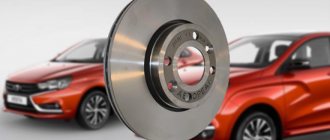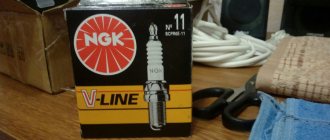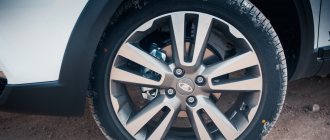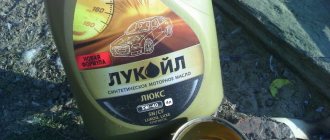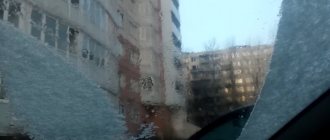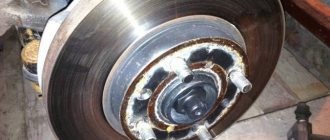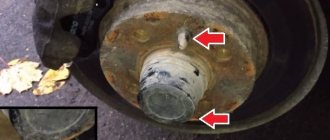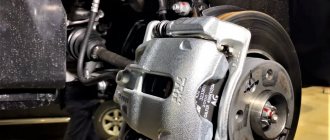Replacing drum brakes with disc brakes Lada Vesta
The Lada Vesta braking system consists of brake mechanisms and electronic driver assistance systems. The car is equipped with disc brakes at the front and drum braking devices at the rear. Every owner should know what rear brakes are installed on the Lada Vesta and how to service them.
Main differences between disc and drum
The braking mechanism consists of several parts and differs in two types of design.
The disk unit has an open design, allowing the device to operate for a long time without overheating.
When you press the brake pedal, the brake pads are pressed against the disc mounted inside the wheel rim using a caliper.
The degree of compression of the disc by the calipers is very high, which allows the car to brake more efficiently. As a result of heavy loads, the mechanism has a relatively short resource.
The drum mechanism has a closed cylindrical body, which prevents the entry of dirt and dust and has a long working life. The brake pads are pressed against the inner surface of the drum, causing the car to stop. The pressing force of the elements is comparatively lower than that of analogues with a disk, therefore such mechanisms are considered less effective.
The combination of front discs and rear drums is optimal in terms of efficiency and durability. This version of the Lada Vesta justifies itself with its reasonable price and reliability.
Rear brakes on Lada Vesta
Each car enthusiast can decide for himself whether to install drum or disc rear brakes on his car. He will not feel much difference from replacing the elements.
Replacing drum brake pads
Before starting work, the handbrake lever should be completely lowered down. The installation process has its own procedure:
- remove the rear wheel;
- using a slotted screwdriver, unscrew the ratchet nut that adjusts the length of the spacer bar;
- remove the block and replace it with a new one;
- install the drum back;
- tighten the bearing nut.
DIY car arch repair video
Replacing the pads involves installing them on both wheels at the rear, otherwise the car will brake with different forces on the wheels and may lose control.
Lada Vesta rear brake pads must be replaced every 50-60 thousand km. But this does not mean that they do not require additional periodic inspection.
Approximately every 15-20 thousand kilometers, it is necessary to inspect the important parts of the car. It is not recommended to buy spare parts at street car markets; there is a possibility of stumbling upon a low-quality product.
The cost of a set of rear brake pads for a drum is about a thousand rubles.
Reviews
| № | Positive |
| 1. | Valery , 43 years old (www.otzovik.com): drove over 53,000 km, did not change the PTC. |
| 2. | Kirill , 39 years old (www.zr.ru): at 26,000 km the PTC creaked for the first time, visited a service station, replaced it with new ones under warranty. |
| 3. | Vitaly , 23 years old (www.autobann.su): the pads squeak only after washing or long trips through puddles. When dry, there are no external sounds. |
| 4. | Georgy , 33 years old (www.lada-vesta.net): the car is two years old from the date of purchase, no capital investments, the systems are working as normal. |
| 5. | Vladlen , 41 years old (www.otzovik.com): there are no comments on the brake circuit, unlike the Lada Grant, the Vesta has good brakes. |
| 6. | Dmitry , 43 years old (www.zr.ru): I won’t praise the car, the system periodically fails, but for me this is not important. |
| 7. | Vitalievich , 25 years old (www.autobann.su): comrades advise installing the PTK from Renault Logan of the second generation, they say, the quality is better there. For now I’ll go with domestic ones. |
| 8. | Zheka , 33 years old (www.lada-vesta.net): when a metallic creak of the pressure plate appears, it means it’s time to replace the PTC. |
| 9. | Konstantin Vladislavovich, 49 years old (www.otzovik.com): my pads lasted over 75,000 km, I think this is a good result. |
| 10. | Leonidovich , 33 years old (www.zr.ru): the car is three years old, I carry out most of the maintenance work myself, and rarely call for service. |
| 11. | Vasily, 36 years old (www.autobann.su): my positive review of the car, good build, decent quality, affordable price. |
| Negative | |
| 12. | Ivan , 42 years old (www.zr.ru): the first time the PTK flew 40,000 km, although the service life according to the instructions is 65 - 70 thousand km. |
| 13. | Vitaly , 38 years old (www.otzovik.com): extremely dissatisfied with the quality of the brake system on the Lada Vesta, in Renault Logan, Megan the circuit is better implemented. |
| 14. | Ivan Vasilyevich , 47 years old (www.autobann.su): I do not recommend buying the model, there are many flaws, defects, it requires investment at the initial stage. |
The best front brake discs
Here are the best front brake discs.
Alnas Sport 2112-3501070-01
These are high-quality cast iron discs that have a long service life. Spare parts provide smooth braking without vibrations. The elements quickly “grind in” to the system and fit like a glove.
The model is characterized by a long warranty period. However, it only applies when parts are installed at a service center, for which there must be appropriate documents.
Alnas Sport 2112-3501070-01
Characteristics:
- material – cast iron;
- minimum thickness – 18;
- number of holes for fasteners – 4;
- centering diameter – 58.5 mm;
- weight – 12 kg.
pros
- excellent quality;
- increased strength;
- long operational period;
- smooth braking without vibration;
- acceptable cost.
Minuses
- If you install it yourself, the manufacturer's warranty will no longer apply.
ATE PowerDisc
These are high-quality German-made brake discs made of high-carbon cast iron. The products are characterized by increased strength, resistance to low temperatures and temperature changes. The elements provide smooth and effective braking without runout. The model is characterized by a long operational period and reasonable cost. The products have reliable protection against the accumulation of gas cushions between these parts and the pads. Therefore, the braking system will not lose its effectiveness due to this.
Basic faults
If we exclude the possible defective parts and poor quality from the manufacturer, then the main reason why the front pads on the Lada Vesta become unusable is wear. They actively interact with other parts of the brake mechanism, and therefore a look at the nature of damage to the friction linings will make it clear what is wrong with the operation of the brake system. By correcting this error, you will increase the service life of not only the pads, but also the entire mechanism.
The nature of the malfunctions can be noted:
- Uniform wear - it manifests itself in the fact that the friction layer is worn evenly, this shows that the brakes are working well.
- Severe wear of the friction layer, brake rivets are visible - this means that you have been using the “outdated” parts for too long. The rivets could damage the disc, so it would be a good idea to inspect it for damage.
- The friction layer is worn evenly around the entire circle, but one of the sides is worn out more than the other - one of the parts of the brake system (guide or piston) does not distribute the braking force correctly. Cleaning all “live” parts and applying a new layer of lubricant will help. Naturally, everything will have to change.
- Both components are worn unevenly, the surface is strewn with irregularities and roughness. The reason for this outcome is a malfunction of the caliper guide pins - they swing and do not give an even trajectory of movement. You will have to clean them, then reapply lubricant.
- The friction lining is cracked - in this case, the “trouble” is caused by the brake discs themselves - they wear unevenly. Everything will have to change.
- Uneven wear of the friction layer means that the parts were installed incorrectly. They will have to be changed.
After performing a visual inspection of the damage, you can independently make a verdict about the breakdown. And besides this, there are several other signs by which you can find out about a faulty front pad while sitting behind the wheel.
Creak
If a squeaking noise occurs from the front when braking, this means that the pad and disc are not mating. This happens when a cheap analogue was purchased to replace the original component. But not everything is so bad - sometimes this analogue can last a long time, but the real reason is dirt that has gotten into the moving parts and reduces the contact area of the moving parts.
Vibration at speed: what is it?
Vibration at speed appears when the pads do not fit the discs - there is some incompatibility that does not manifest itself in the operation of the “original” parts. If, when braking, you still get “full contact” of these parts of the brake mechanism, this means that the wear of the hub discs themselves is haunting, and they will have to be replaced.
The best rear brake discs
Here are the best items for the rear axle.
TRW DF7257
These are high-quality wear-resistant products that provide fast and easy braking without vibration or wobble. The elements do not overheat even after driving for many hours. The parts are characterized by increased strength and long service life.
Characteristics:
- material – cast iron;
- minimum thickness – 8.5;
- number of holes for fasteners – 5;
- centering diameter – 62 m;
- weight – 10.8 kg.
pros
- high quality;
- reliability;
- absence of beating and vibration during braking;
- do not make unpleasant sounds;
- long working life;
- good equipment;
- proven brand.
Minuses
- there are fakes;
- high price.
BM BDV 292
This is a high-quality model that is characterized by wear resistance. The spare part will serve for a long time even under conditions of increased loads and daily use of the vehicle. The model provides high-quality braking even if the car is moving at high speed. In this case, vibration and beating do not occur.
Characteristics:
- material – cast iron;
- packaging – 1 pc.;
- packaging – 27.6x27.6x3 cm;
- weight with packaging – 14.4 kg.
pros
- long service life;
- fast braking even at high speed without beating or vibration;
- there are no squeaks or other unpleasant sounds;
- reliability;
- excellent quality.
The best front wheels for Lada Granta
When compiling a kind of rating, we studied reviews of owners, parameters, price and quality. Among the best analogues, four candidates can be distinguished.
Sport Alnas, from RUB 1,700. (21-12-350-1070-01)
Brake discs made of cast iron are characterized by a long service life. The parts quickly grind into mating elements and fit well into place. It is worth noting that the manufacturer's warranty does not apply to self-installation. Thickness – 18 mm, number of mounting slots – 4, weight – 12 kg. The owners consider the optimal combination of cost and quality indicators to be the main advantage.
Brembo Max, from RUB 2,800. (09-8903-75)
Discs from an Italian manufacturer show efficient operation, there are no beats or vibrations. The elements are easy to install. If there are unpleasant sounds after the replacement, do not be upset; after 2-3 days they disappear.
Brief characteristics:
- thickness (mm) – 18;
- mounting holes – 4 pcs.;
- centering (mm) – 58.5 mm;
- tightening torque – 75.
Bosch, from 1,500 rub. (098647-9346)
Budget discs that are not inferior in quality to expensive analogues. When braking, vibration moments and beating do not occur. The advantages of the devices include increased strength and durability. The products are made of cast iron (thickness is 18 mm, with a centering diameter of 58.5 mm). Good protection against counterfeiting, available at most points of sale.
ATE Power Disk, from RUB 3,500. (24.0120-0187/1-420187)
The best brake discs for the front wheels of Lada Granta cars are made in Germany. The advantages include increased strength, smooth and effective brake operation. These devices are resistant to temperature fluctuations, which is important for the harsh climate of Russia. Models made of high-carbon cast iron have thoughtful protection against the accumulation of a gas cushion between the discs and pads.
Options:
- minimum thickness – 23 mm;
- mounting sockets – 5 pcs.;
- weight – 8.3 kg;
- centering – 63.5 mm.
The procedure for replacing parts is as follows:
- Secure the vehicle in place by applying the parking brake. Turn off the ignition. Raise the front of Vesta with a jack;
- Proceed to remove the wheel. Remove the cap, loosen the bolts one turn. Continue this action in a circle with all the bolts;
- Remove the brake fluid reservoir cap and pump out a few milliliters. This will prevent the liquid from coming under pressure. Press the brake cylinder inward with a screwdriver;
- Use a 15mm wrench to hold the caliper guide pin, and use a 13mm wrench to remove the two bolts. Do not let the free part of the caliper fall to the ground;
- Pry up the outer pad with a screwdriver and carefully remove it. In the same way, remove the inner block;
- The spring retainer, which is responsible for uniform wear, will have to be cleaned and then re-coated with lubricant;
- Install a new part - first the external one, then the internal one;
- Clean the guides and also coat them with lubricant;
- Put all the parts back;
- Tighten the fastening bolts, install the wheel, clockwise, one rotation at a time, secure all the bolts.
Replacing brake discs
You can replace the brake discs yourself. The main thing is the availability of a place for work, as well as the necessary materials and tools. When performing the corresponding manipulations, you should remember that the procedure for replacing the front and rear parts of a car has some differences.
Required materials and tools
To replace brake discs, you will need the following materials and tools:
- the spare parts themselves;
- jack;
- wrenches designed for nuts 7, 13 and 17 mm, as well as a wheel wrench;
- torx head t12 for unscrewing and dismantling the caliper;
- lubricant;
- extension;
- ratchet;
- hammer.
Replacing front brake discs
To replace the front elements, proceed as follows:
- Remove the wheel and raise the vehicle using a jack.
- Remove the guide fasteners and swing out the brake pad to remove the old pads.
- Place the bracket on the pendant.
- Unscrew the disk fasteners, lubricate them to facilitate dismantling, and then remove the elements - if the elements cannot be removed, carefully hit them with a hammer from the back side.
- Install new parts and tighten fasteners.
Attention! When performing the disc replacement procedure, it is also recommended to install new pads.
Replacing rear brake discs
To change the rear elements, follow these instructions:
- remove the wheel and lift the vehicle using a jack;
- remove the caliper, pads and disc;
- install new spare parts - first install the disc, then assemble the caliper and secure the pads.
Installation
Replacing brake pads on a Lada Vesta yourself is not difficult. First you should prepare for work.
- Slotted screwdriver;
- Key to 13;
- Key for 15.
First you need to open the hood and check the brake fluid level in the reservoir. If it is at the Max mark, you will need to pump out the part using a syringe so that when the piston is retracted into the cylinder, the brake fluid does not flow over the edge. When this is finished, all that remains is to jack up the Vesta and remove the wheel. Don't forget to put a support on it for security.
The first step is to press the piston into the cylinder. To do this, a slotted screwdriver is inserted between the piston and the brake pad (inner), which presses the piston. However, you need to work carefully so as not to damage the cylinder boot, otherwise it will have to be replaced.
First we press the piston into the cylinder.
Then we proceed to unscrew the bolt that secures the brake caliper with the guide pin (lower). The pin itself is held with a 15mm wrench, while the bolt is unscrewed with a 13mm wrench.
Next, lift the brake caliper up. The brake fluid supply hose does not need to be disconnected.
Once the caliper is lifted, all that remains is to remove the worn out brake pads and remove the spring calipers. There are probably traces of corrosion and dirt on them and on the seats for the pads - they need to be cleaned with a metal brush.
Before installing new pads, it is necessary to inspect the condition of the guide pin boots. If the cover is defective (crack, etc.), the pin must be removed and the boot itself must be replaced. The lower finger simply unscrews, but if you need to put a new boot on the upper finger, then when unscrewing it, you will have to remove the brake caliper itself. When installing the pins back, you need to apply a little lubricant to them.
After checking, all that remains is to install new pads and secure them with spring clips. Assembly is carried out in reverse order.
Work with the second wheel is carried out in the same way.
When replacing the brake pads on Vesta is completed, all that remains is to press the brake pedal several times and also check the brake fluid level in the reservoir. If it is less than normal, you need to top it up.
The video clearly demonstrates the process of replacing pads on Vesta
Mechanics recommend that after replacing the pads on the Vesta, drive carefully and steadily for at least the first 100 km (or better yet, 500 km). Braking should be done smoothly to allow the new pads to get used to the brakes.
Replacing the pads on Vesta yourself does not take much time; moreover, the work does not require specific tools and skills. Therefore, it will be an excellent opportunity to work on the car yourself and save money, because service stations charge about 500 rubles for a replacement.
Source
Which discs are better for Grants in different conditions?
Three different types of brake discs are installed on the Granta. Often users install similar parts from foreign cars to speed up the ride or to save money.
In the city and on the highway
Under normal operating conditions, factory cast iron discs or any other equivalents are suitable. If you have the original 13s and are not enough, change to a 14th size. It's easy to change them, and the car will brake much better.
Remember that you have an inexpensive sedan, not a race car. Do not overheat the brakes and if you drive through a water obstacle in the form of a puddle, dry them by briefly pressing the brake pedal. It doesn't make sense to pay more for ceramics for quiet use.
For lovers of fast driving
If you like to race, think about good brakes. For this purpose, 15-size perforated wheels with grooves or other sports wheels are suitable for the Granta. If you have a passion for this car and you are tuning it, install ceramics. Although it is expensive and needs to be warmed up, it is best suited for sports use.
Don't expect that having an ABS system will save you money on brakes. It prevents wheel locking, but does not improve braking performance in any way.
Off-road
If you want to try a front-wheel drive sedan as a trophy truck, then there is no point in thinking about good brakes. The speed will be comparable to a pedestrian, so you can install cheap brakes or leave standard (factory) ones if they are in good condition. If you're thinking of taking part in a rural rally at high speed, think about good wheels.
If the car is used for fast driving, do not skimp on the brakes. And it’s better not to drive. “Granta” is not intended for this, the security level is also low. The guarantee of your life is impeccable compliance with traffic rules. For fast driving, racing tracks have been built taking into account safety requirements. It is better to practice extreme driving on them.
Discs and drums
Disc brakes, which are installed on the front wheels of the new Lada Vesta sedan, operate on the principle of pads. The discs are manufactured in such a way that they receive good cooling and avoid excessive heating, which can negatively affect their performance and driving safety.
Advantages of disc brakes on Lada Vesta:
- they are better cooled due to constant ventilation and air circulation;
- discs quickly get rid of water and dirt that regularly fall on them;
- The location of the disc brakes on the front wheels gives the car an advantage in braking speed, thanks to which the driver avoids many dangerous situations on the road.
The rear wheels of the Lada Vesta have drum brakes. They, like disk ones, comply with all modern international quality standards and ensure the safety of car owners. The drum system is better suited for driving on bad roads and off-road.
Such brakes work more effectively on unpaved, muddy and dusty roads. They work well even in the most unpleasant weather conditions for the Lada Vesta, but also function well on asphalt.
The combination of drum and disc systems allows the Lada Vesta driver to feel confident on any road, regardless of weather conditions and other external factors. The brakes work with equal efficiency both during fast and quiet driving.
What front brake discs should be installed on the Lada Granta
The front wheels of the Lada Granta are equipped with disc shoe brakes. What makes the pedal informative is that it makes it easy to calculate where to stop.
The power reserve with original parts can range from 50 to 120 thousand km. But sooner or later the need for replacement arises.
You can divide all supplied spare parts into two main categories: original and analogues. The former are more expensive. But at the same time, their maximum mileage is usually an order of magnitude greater than their analogues. There is multi-stage quality control in production. The downside is the high cost. Sometimes it is 2-3 times more than analogues.
The latter are distinguished by their availability. But not all parts are reliable. It is best to give preference to well-known brands that have proven themselves on the positive side.
Original
The advantage is exact compliance with the specified dimensions. After purchasing the part, there is no need to adjust it to size or grind it down:
How to choose brake pads
Car enthusiasts believe that original pads are much more efficient and durable than their numerous analogues. Standard spare parts recommended by the manufacturer are produced without the use of asbestos in a composition that has been proven to be hazardous to the environment. But many car owners are considering the option of purchasing non-original spare parts. The main criterion for this choice is the low cost of analogues. On the car parts market you can find non-original brake pads of fairly high quality, not inferior to the original. But there are many outright fakes - to avoid buying them, you should purchase spare parts and consumables in trusted places or directly from an official Lada dealer.
What rear brake discs can be installed on the Lada Granta
Despite the fact that this car belongs to the budget class and is one of the cheapest among those sold in the Russian Federation, it is equipped with rear disc brakes. Which implies the need to replace individual components. The price of parts depends on their type, as well as other factors.
It is important to remember: the front and rear discs differ in the diameter of the mounting holes and other parameters. Installation can be done by yourself. The process itself is simple. But it requires some preparation. It is important to decide on a budget for parts in advance. All of them are divided into two main categories - analogues and originals. They differ in price and quality.
There are many types of discs. These are ventilated, with notches and various others. If the driver practices an aggressive driving style, then you should opt for ventilated models. They cool faster. They have more resources. The replacement process is no different from the others.
Original
Buying original parts is a good solution if you have an unlimited budget. AvtoVAZ products are quite expensive. Especially when compared with analogues from China. Original TD:
NameArticle Cost, rubles
| AvtoVAZ brake disc (can be marked as Renault) | 432007595R | 9 thousand rubles per pair |
Analogs
The cost of original components is an order of magnitude higher than analogues. Therefore, the choice of many vehicle owners falls on substitutes. The most advantageous offers:
NameArticle Cost, rubles
| A.S.P. | 2702220 | 2 thousand rubles. for 1 piece |
| B.M. | BDV 885 | 1 thousand rubles for 1 piece. |
| Hella | 8DD355109331 | 1.6 thousand rubles for 1 piece. |
Lada Vesta: replacing the brake pads of the front wheels
February 18, 2022 Lada.Online 159 653 34
Unlike rear brake pads, front brake pads are replaced more often. This is due to the fact that they bear the main load during braking. Not only the braking efficiency, but also whether they will creak during operation depends on the quality of the brake pads. Do you know which pads are best for Vesta?
Original front brake pads
- 8200432336 or 410608481R Renault, price about 1850 rubles.
- 8450108101 "TIIR" JSC, Yaroslavl, price about 1150 rubles.
- 8450038536 "Lada-Sport" LLC, Tolyatti, price about 2750 rubles. (Lada Vesta Sport)
- TRW - GDB 3332
- Brembo - P68033
- Motrio LS-KTLL
- UBS Performance BP11-05-007
- MILES - E100108
- REMSA - 0987.00
- FERODO - FDB1617
- ASAM - 30748
- HI-Q Sangsin Brake – SP 1564
- LYNXauto - BD5739
- SAT - ST4106000Q0K
- Hagen Sangsin Brake - GP 1564
- Blitz - BB0292
- Galfer - B1G10207412
- ATE - 13.0460-2709.2
- Zekkert - BS-1221
- Trialli PF1402
- and etc.
Original rear disc brake pads
- TRW GDB1384
- Sangsin Brake SP1709
- UBS - B1105007
- Brembo P23064
The brake pad consists of a metal plate and a special lining made of friction materials. The quality of this material determines the wear resistance, rigidity and friction coefficient of the brake pad. The higher these important parameters, the better.
Replacing front brake discs
The replacement algorithm includes the main steps:
- it is necessary to remove the wheel and jack up the car;
- the old brake pads are removed - to do this, the guide bolts are unscrewed and the caliper is folded back;
- The bracket is carefully hung on the suspension, after which you can begin to remove the disk - two nuts are unscrewed;
- if for some reason the disk cannot be removed from the bolts, you need to lightly hit it with a hammer from the reverse side;
- The new disk is carefully installed.
The nuts are screwed into place. It is advisable to pre-lubricate the threads with graphite lubricant. This will prevent souring. It is advisable to change the pads along with the discs.
Step-by-step instructions for replacing front pads on a Lada Vesta car
Required materials and tools:
- keys to “13”, “15”;
- wheel wrench;
- rags;
- a set of new PTC;
- graphite-based lubricant;
- rust remover;
- additional lighting as needed.
Algorithm of actions:
- We jack up the car and use a hydraulic lift for convenience.
- Using a wheel wrench, unscrew the bolts and remove the wheel.
- From the back of the brake caliper, unscrew the two guide bolts.
- We open the spacer bar and move the pads apart.
- We remove each pad one by one.
- We carry out preventative maintenance, install new ones, and assemble the structure.
Replacing rear brake discs
The algorithm for replacing rear brake discs is as simple as the front ones. The process is similar. Its main stages:
- it is necessary to remove the wheel to gain access directly to the part - the car is raised on a jack or lift;
- the caliper is removed along with the pads - you can place it side by side or hang it on a spring;
- use an open-end wrench to unscrew two nuts;
- a new disk is installed.
Assembling the caliper, installing the pads - everything is done in the reverse order. It is necessary to ensure that the thickness of the brake disc corresponds to that specified by the manufacturer. If you have difficulty removing the pads, you need to press in the cylinder with a screwdriver. If difficulties arise with unscrewing threaded connections, you need to use WD-40.
2283-14-02-07 (Copy)
...and apply a thin layer of lubricant to the surface of the finger. ...and apply a thin layer of lubricant to the surface of the finger.
We install new brake pads in the pad guide and then assemble the assembly in the reverse order.
We similarly replace the pads on the other side of the car.
After replacing the pads, press the brake pedal several times to set the gaps between the pads and discs. We check the fluid level in the tank and, if necessary, bring it up to normal.
During operation, the surface of the brake disc becomes uneven, as a result of which the contact area of the new, not yet worn-in pads with the disc decreases. Therefore, during the first 100 km of driving after replacing the pads, until the new pads have broken in, be careful, as the car’s braking distance may increase, the pads may heat up more than usual, up to the appearance of light smoke and smell, especially in hot weather.
Lada Vesta: replacing the brake pads of the front wheels
Possible difficulties and solutions
Difficulties in dismantling a worn element may arise at the initial stage - bending of the edges of the plate. It is not always possible to successfully catch the edge and bend the material in the desired direction. If the owner cannot get a grip with pliers, you can use a rigid screwdriver or pliers, placing the working rod in the eye, after which the lever method is used to bend it.
- It is always better to use original spare parts or suitable replacements;
- The rear wheels are securely fixed with wheel chocks;
- Replacement is carried out only comprehensively;
- After completing the procedure, it is necessary to monitor the brake fluid level.
You should not worry if you experience an unpleasant sound after replacement. New elements should get used to the brake discs after several thousand kilometers.
Causes and signs of worn pads
The need for replacement or preventative inspection of the pads can be determined by a number of characteristic signs. Malfunctions consist either in low-quality components, causing destruction of the friction material, or in natural wear.
Increased parking brake travel
Since the Lada Vesta is equipped with rear drum brakes, this feature is relevant for it. Normally, the handbrake is raised 3 or 4 clicks. A sign of wear is a rise of 5-7 clicks. When stopping on a hill, the car rolls with the handbrake raised - the handbrake does not hold. The problem may be a stretched cable, but it wouldn't hurt to check the pads.
The wear sensor gives a signal
Vesta is equipped with a brake pad wear sensor in the maximum configuration. When the friction material lining thins to a critical level, the sensor will begin to make a characteristic sound with each braking. On some cars, an electronic type sensor is installed; it signals wear and tear with a warning light on the instrument panel.
Brake fluid level decreases
If the main element of the brake system is in a worn condition, then in order to effectively press it against the disc or caliper drum, the cylinders must exert more force, using more fluid. Accordingly, a decrease in its level can be observed. The volume of brake fluid may decrease if the cylinders are faulty, hoses or lines are damaged.
Long travel brake pedal
As in the previous case, if the pads are worn out enough, then greater effort is required to press them, and accordingly, the pedal stroke increases.
Damage to pads
On disc brakes, mechanical damage (flaking, chips, cracks) can be seen with the naked eye. They can also be found on the disks themselves.
Unevenly worn pads
If increased wear of the friction material is observed on one side relative to the other, this may indicate a failure (jamming) of one of the calipers. If you do not change it, then replacing a set of pads will do nothing - the wear will be just as uneven, and braking will be ineffective and even dangerous, since the car will pull to the side.
Increased braking distance
It is urgent to replace spare parts of the brake system if the car’s braking distance has become unnaturally long. Low braking efficiency may indicate severe wear of the front pads - they wear out much faster than the rear ones, as they take a greater load. Another reason could be a faulty caliper, a leaking system, or low brake fluid levels.
You can determine the degree of wear yourself; it takes no more than an hour. All you need to do is remove the wheels and inspect the friction material. In the case of drums, you need to remove them first. At the same time, you can assess the condition of the drums and discs for wear, cracks and other mechanical damage.
In the most advanced cases, the indicator of critical pad wear will be a grinding noise when braking. This occurs when the lining wears down to the base and the metal plates of the pads begin to rub against the discs or drums. Operating a vehicle with such wear is prohibited, as it can lead to jamming of the drums and serious damage to the discs, which ultimately will require them to be completely replaced.
